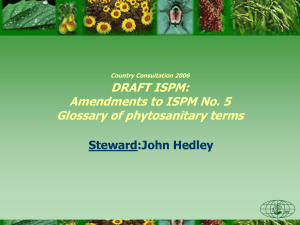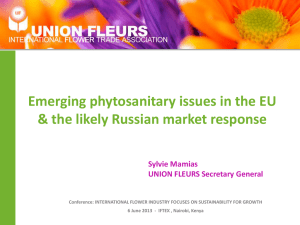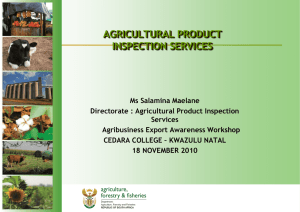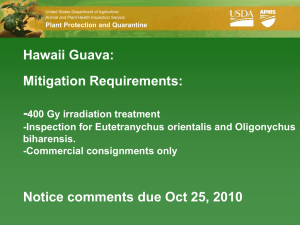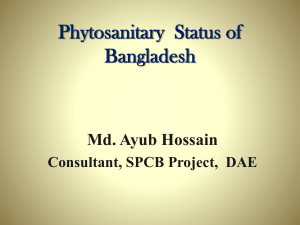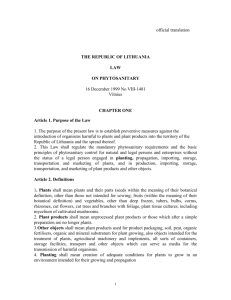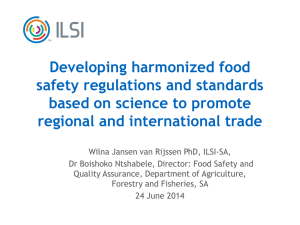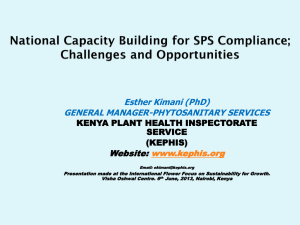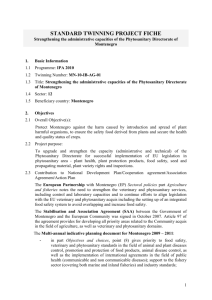Predlozak
advertisement
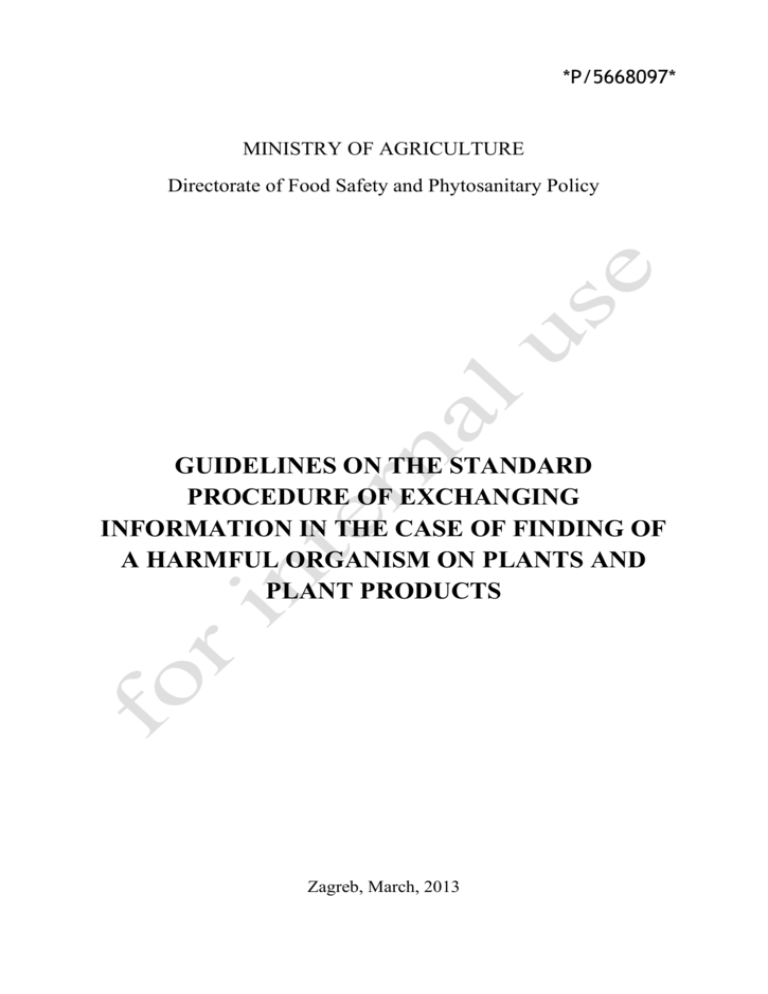
*P/5668097* MINISTRY OF AGRICULTURE Directorate of Food Safety and Phytosanitary Policy GUIDELINES ON THE STANDARD PROCEDURE OF EXCHANGING INFORMATION IN THE CASE OF FINDING OF A HARMFUL ORGANISM ON PLANTS AND PLANT PRODUCTS Zagreb, March, 2013 A) PURPOSE OF THE GUIDELINES The main purpose of this guidelines is to describe procedure of exchanging information between plant health providers (hereinafter: providers) in case of suspicion on the occurrence or finding of a harmful organism (HO). This guidelines allows the uniform working procedure of all providers. They are obligated to exchange information on suspected occurrence and finding of a HO between each other in a timely manner. The purpose of exchanging information in a timely manner is to take appropriate measures to prevent the introduction, spread or eradication of a HO. B) SPECIFIC SCOPE This guidelines applies in the plant health area regulated by the Plant Health Act (hereinafter: Act) (OJ 75/05 and 55/11), with aim to protect plants and plant products in the agriculture, forestry, trade and environment from significant economic losses which HO’s may cause. This Act includes procedures for collecting information about HO’s, as well as the responsibilities and obligations of providers related to procedures of collecting and exchanging the information. Guidelines is applied in the case of finding of a HO that can cause significant economic losses in agriculture, forestry and the environment on the territory of the Republic of Croatia where the HO had not been present or is already present and it is not widespread. C) PROVIDERS AND THEIR RESPONSIBILITIES AND OBLIGATIONS According to the Act all providers are obligated to conduct a constant surveillance. Constant surveillance is the official process of collecting and recording data about the presence or absence of HO’s based on phytosanitary examination, monitoring, systematic research and implementation of other procedures related to phytosanitary surveillance and collecting data from other available sources. Providers are obligated to cooperate with each other and share collected data about new and unusual occurrence of a HO in a way explained in Section D of this Guidelines. According to Article 4 of Act providers are: 1. Responsible Official Body (ROB) conducts constant surveillance based on data obtained from other providers and aligns their work, based on exchanging data with authorities in other countries, regional and international organizations and data collected from other available sources. Keep records about the findings of HO’s, exchanges data on that and provides information to the competent authorities of other countries, regional and international organizations in accordance with the requirement based on International Plant Protection Convention (IPPC). Collected data on the presence of a HO allow assessment of the phytosanitary situation in the Republic of Croatia and beyond, assessing the degree of risk of introduction and spread of a HO as the basis for the adoption of regulations and other phytosanitary measures to prevent the introduction, control or eradication of a HO. 2. Phytosanitary Inspection (PI) collects data about presence or absence of HO by conducting monitoring, phytosanitary examination during introduction of consignments from third countries, export of consignments and movement, conducting of constant surveillance, inspections of production, processing and market, collecting the results of laboratory analysis and data from other relevant sources. MA – DFSPP – SPP – Guidelines on the standard procedure of exchanging information in the case of finding of a harmful organism on plants and plant products – March 2013 3. Forestry Inspection (FI) collects data conducting the monitoring, special surveillance of a HO, inspection surveillance of forest plants, collecting the results of laboratory analysis and data from other relevant sources. 4. Croatian Centre for Agriculture Food and Rural Affairs - Institute for Plant Protection (IPP) collects data conducting monitoring, special surveillance, forecasting and reporting activities, diagnostics and collecting information from other relevant sources. 5. Croatian Forest Research Institute (CFRI) collects data conducting the monitoring, phytosanitary examination in relation to the movement, special surveillance, forecasting and reporting activities, diagnostics and collecting information from other relevant sources. 6. Legal and natural persons providing services to implement plant health procedures including service providers according to the Article 37 of Act on Plant Protection Products (OJ 70/05). D) EXCHANGING DATA ABOUT A HO’S 1. Method of sending data: The data has to be send by fax or e-mail. 2. Data content: - the place of examination (plant owner, address, contact number, e-mail address); in the case of imported consignment specified point of entry, the name and address of the exporter, the name and address of the importer, - date of examination, type of examination (special surveillance, phytosanitary examination at the point of entry or at the owner, monitoring…), - type of HO, - host (plants, plant product), - host origin, - amount of infected plants or plant products or projected area of crops/plantation where the infection is occurred. Phytosanitary and forestry inspector sends data by sending minute of examination and/or the decision on ordered measures. Diagnostic laboratory sends the results of analysis to the competent inspector and ROB on the prescribed forms. 3. Sequence of actions 3.1. Each of these providers has to send notification to ROB and regional phytosanitary inspection unit immediately after finding signs that lead to suspicion about the occurrence of a HO during the official procedures. When it comes to forest HO providers has to send information to ROB and CFRI according to Act and regulations regulating forestry area. 3.2. If ROB receives information about the suspected occurrence of a HO, Sector of Phytosanitary Inspection and Sector of Phytosanitary Policy immediately exchanges received information. Sector of Phytosanitary Inspection sends data to the relevant regional office of Phytosanitary Inspection. When it comes to HO that affects forests, ROB exchanges data with the Directorate of Forestry and Hunting. 3.3. Authorized inspector takes a sample and sends it to the diagnostic laboratory (IPP or CFRI) to laboratory analysis, orders appropriate measures and sends report about that to the ROB. 3.4. Laboratory sends information about the results of analysis to responsible inspection and ROB. MA – DFSPP – SPP – Guidelines on the standard procedure of exchanging information in the case of finding of a harmful organism on plants and plant products – March 2013 3.5. When the result of the analysis is negative, inspector recalls temporary measures and notifies owner about results of the analysis and the abolition of measures, and sends the information to the ROB. 3.6. When the result of the analysis is positive, inspector notifies owner, orders him regulated measures and sends information about measures to the ROB. 3.7. ROB sends a notification about findings and actions that has been taken to: - all relevant providers, - neighbouring countries, - country of origin of the consignment in which the HO has been found, in case when HO is found in the imported consignment, - contact person for EPPO, - contact person for IPPC, - each member state of the listed organizations to its inquiry. 3.8. When phytosanitary inspectors at the point of entry intercepts the consignment because of suspicion on contamination or when the contamination is confirmed, inspector notifies the ROB and other points of entry. 3.9. When phytosanitary inspector intercepts the consignment from third country and laboratory analysis confirms that the consignment is contaminated with HO, inspector notifies the ROB and all posts according to procedures prescribed by Manual for phytosanitary inspectors. 3.10. ROB keeps a record of the findings of a HO that contains information in accordance with International Standards for phytosanitary measures no. 17 - Reporting on the harmful organisms: - botanical name of a HO - date on the reports of findings - name of the institution that has determined HO, - location of finding, - host plant species, - description of symptoms and photos, - description of a HO and photo, - spread of a HO. KLASA: 320-20/13-01/48 URBROJ: 525-09/1087-13-2 Zagreb, 26. ožujka 2013. godine MA – DFSPP – SPP – Guidelines on the standard procedure of exchanging information in the case of finding of a harmful organism on plants and plant products – March 2013 E) ILLUSTRATION OF DATA EXCHANGE Sector of Phytosanitary Inspection Sector of Phytosanitary Policy Sector of Inspections in Forestry Sector of Forestry and Hunting Phytosanitary Inspection or Forestry Institut – sampling, ordering temporary measures Owner - implements temporary measures Diagnostic laboratory Plant Health or Croatian Forest Research Institute determination Finding Finding Owner - informed about finding and recalling the measures Directorate of Forestry, Hunting and Wood Industry Responsible Official Body Provider – suspects on infection with HO + Contact person for EPPO, IPPC _ Phytosanitary Inspections or Forestry Institute recalls temporary measures Phytosanitary Inspections or Forestry Institute orders further implementation of measures Owner conducts further measures osobe NPPO of the relevant country Evidence about the HO Relevant providers Responsible Official Body Sector of Phytosanitary Inspection Sector of Phytosanitary Policy Directorate of Forestry, Hunting and Wood Industry Sector of Inspections in Forestry Sector of Forestry and Hunting
